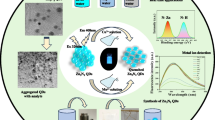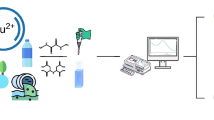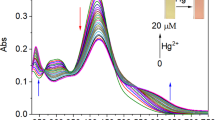Rapid detection of trace heavy metal ions in water is of great relevance to the environment and human health in the future. With pyrimidine as the parent structure, the water-soluble thiourea group is skillfully introduced to form a symmetric framework, thus firmly capturing the heavy metal ions in the water. The responsiveness of heavy metal ions in water was observed by UV-fluorescence spectroscopy. Especially with Co(NO3)2, Cu(NO3)2, Ni(NO3)2, and Zn(NO3)2, the response changes are most significant. The rapid response changes between them and trace heavy metal ions in water were intuitively observed under sunlight and fluorescence irradiation environment.
Similar content being viewed by others
References
J. E. Ruprecht, S. C. Birrer, and I. L. Turner, Water Res., 200, Article ID 117206 (2021), doi: https://doi.org/10.1016/j.watres.2021.117206.
A. Demcakova, B. Sera, and M. Sery, Fresenius Environ. Bull., 30 (2A), 2045–2052 (2021).
A. Pratush, A. Kumar, and Z. Hu, Int. Microbiology, 21, No. 3, 97–106 (2018), doi: https://doi.org/10.1007/s10123-018-0012-3.
T. Ohtani, N. Uematsu, and M. Fukami, Water, Air, Soil Poll., 130, 751–756 (2001).
D. Liu, J. Wang, H. Yu, H. Gao, and W. Xu, Environ. Sci. Eur., 33, No. 1, 42 (2021), doi: https://doi.org/10.1186/s12302-021-00487-x.
J. Jin, J. Sun, K. Lv, X. Huang, J. Wang, and Jia Liu, J. Mol. Liq., 334, Article ID 116087 (2021), doi: https://doi.org/10.1016/j.molliq.2021.116087.
M. Javed and N. Usmani, Proc. National Academy of Sciences, India, Section B: Biological Sciences, 89, No. 2, 389– 403 (2019), doi: https://doi.org/10.1007/s40011-017-0875-7.
N. A. El-Ghazaly, E. H. Abdel-Aziz, and A. El-Gawaher, Egyp. J. Aquatic. Res., 32, No. 1, 298–315 (2006).
J. Patwa and S. J. S. Flora, Int. J. Mol. Sci., 21, No. 11, 3862 (2020), doi: https://doi.org/10.3390/ijms21113862.
Z. Fu and S. Xi, Tox. Mech. Methods, 30 (3), 167–176 (2020), doi: https://doi.org/10.1080/15376516.2019.1701594.
A. T. Jan, M. Azam, and R. Mohd, Int. J. Mol. Sci., 16, No. 12, 29592–29630 (2015), doi: https://doi.org/10.3390/ijms161226183.
X. Zeng, X. Xu, Boezen, and X. Huo, Chemosphere, 148, 408–415(2016).
M. Zalewska, A. Gawin, M. Sciskalska, and H. Milnerowicz, Int. J. Environ. Anal. Chem., 94, No. 14–15, 1422–1434 (2014), doi: https://doi.org/10.1080/03067319.2014.962530.
M. Deng, Y. Zhu, K. Shao, and J. Shen, J. Environ. Manag., 260, Article ID 110092 (2020), doi: https://doi.org/10.1016/j.jenvman.2020.110092.
J. Zhang, Y. Wang, and Q. Zhou, J. Soi. Sediments, 16, No. 2, 634–644 (2016), doi: https://doi.org/10.1007/s11368-015-1225-0.
M. Babu, D. H. Dwivedi, Y. R. Ram, and M. L. Meena, Afr. J. Agri. Res., 8, No. 22, 2765–2768 (2013), doi: https://doi.org/10.5897/AJAR12.1312.
X. Liu, Q. Song, Y. Tang, W. Li, and F. Wang, Sci. Total. Environ., 463–464, 530–540 (2013), doi: https://doi.org/10.1016/j.scitotenv.2013.06.064.
M. D'Emilio, R. Caggiano, M. Macchiato, M. Ragosta, and S. Sabia, Environ. Monito. Assess., 185, No. 7, 5951–5964 (2013), doi: https://doi.org/10.1007/s10661-012-2997-y.
Author information
Authors and Affiliations
Corresponding author
Additional information
Abstract of article is published in Zhurnal Prikladnoi Spektroskopii, Vol. 91, No. 2, p. 314, March–April, 2024.
Rights and permissions
Springer Nature or its licensor (e.g. a society or other partner) holds exclusive rights to this article under a publishing agreement with the author(s) or other rightsholder(s); author self-archiving of the accepted manuscript version of this article is solely governed by the terms of such publishing agreement and applicable law.
About this article
Cite this article
Wang, Z., Jin, F. Rapid Detection of Heavy Metal Ions Co3+, Cu2+, Ni2+, and Zn2+ in Wastewater By Pyrimidine–Thiourea Ligand. J Appl Spectrosc 91, 428–433 (2024). https://doi.org/10.1007/s10812-024-01737-5
Published:
Issue Date:
DOI: https://doi.org/10.1007/s10812-024-01737-5




